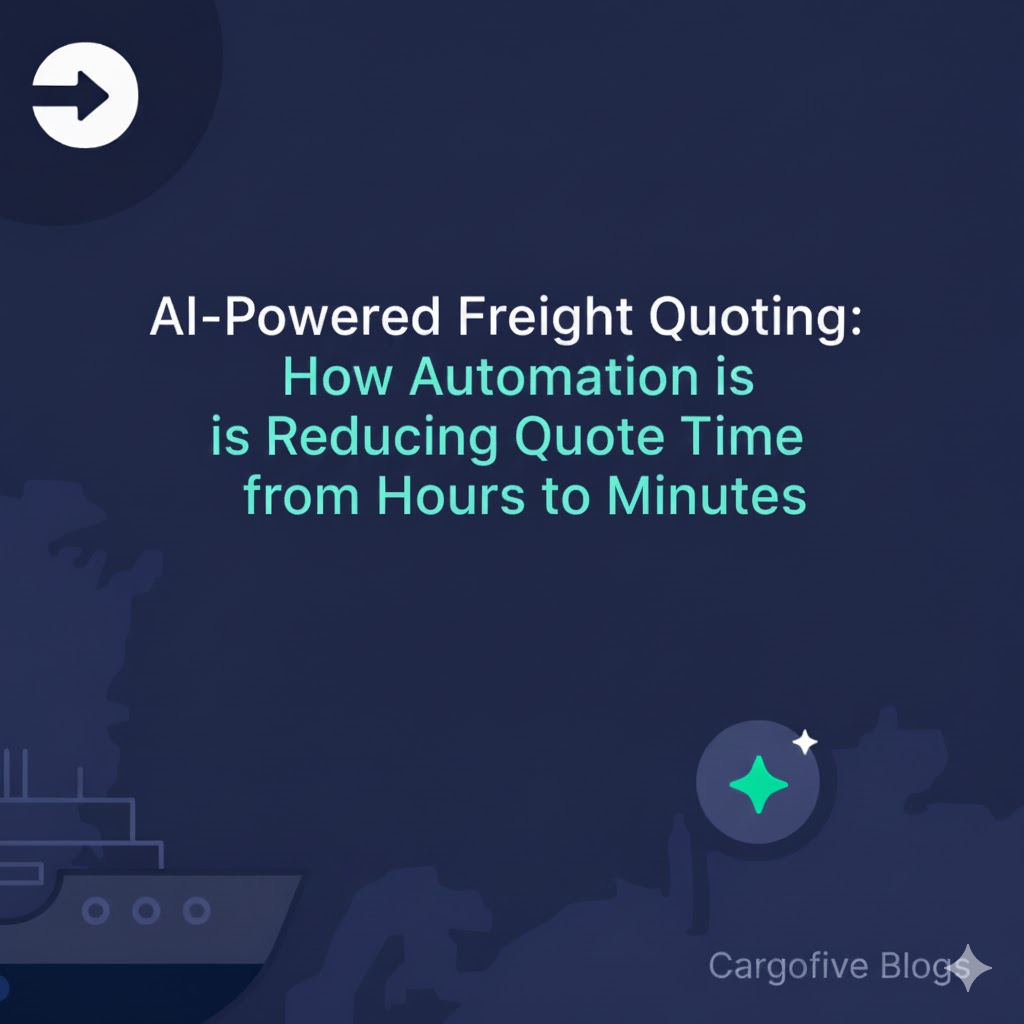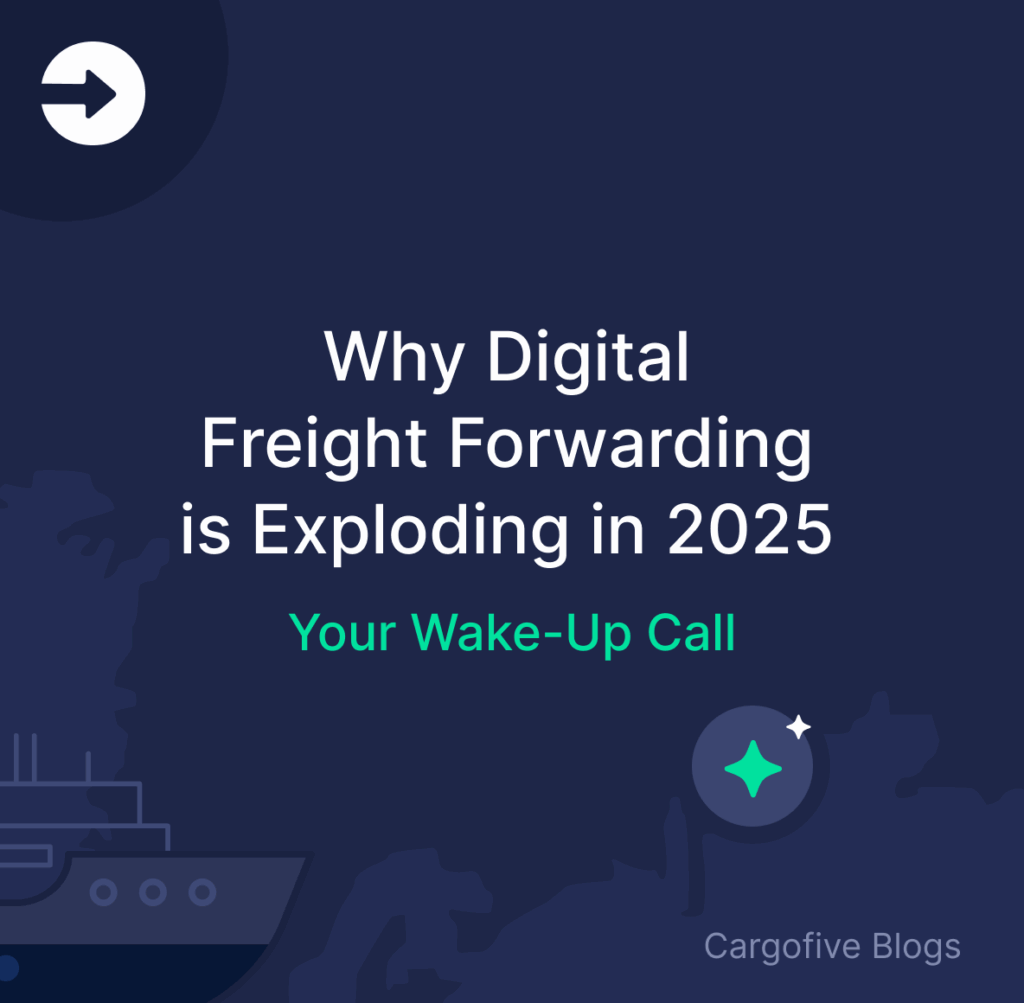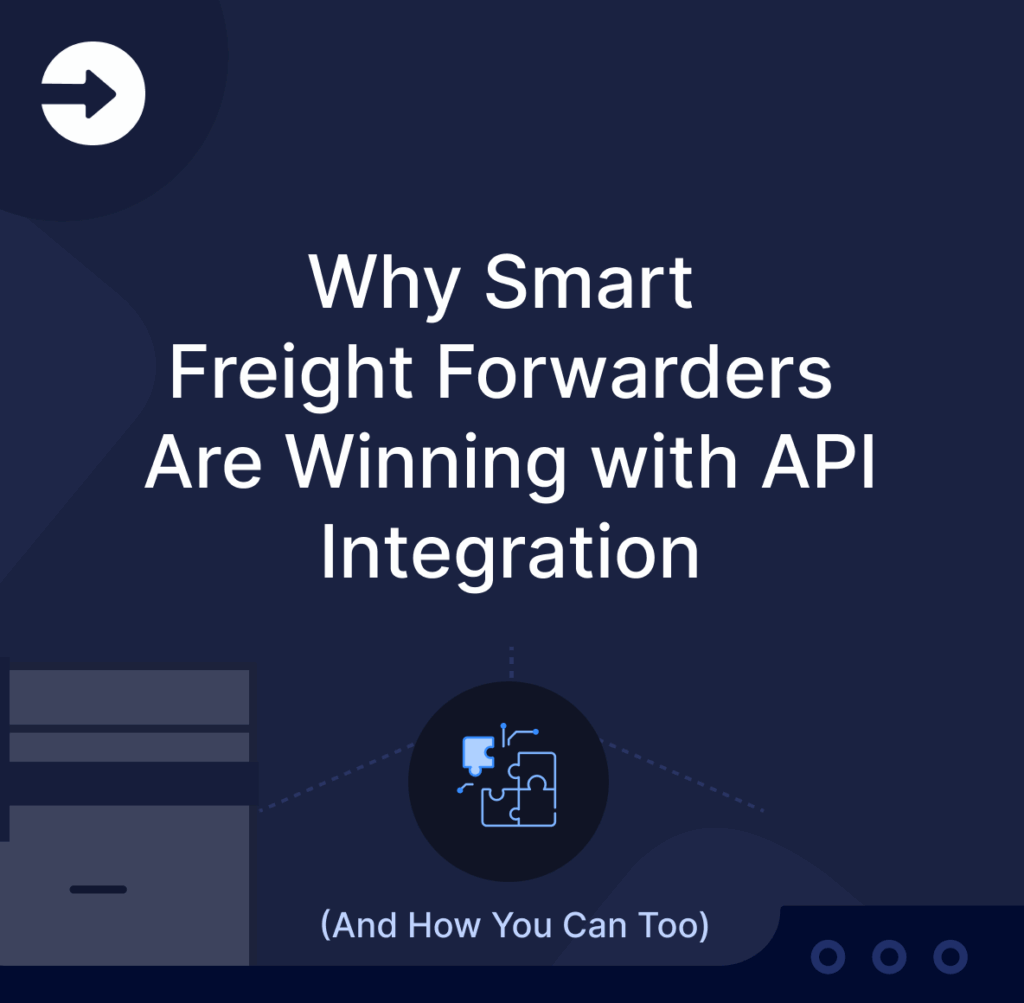Global trade is being reshaped right before our eyes. If you’re a freight forwarder managing ocean freight operations, you’re feeling these changes every single day.
Volatile container rates, rerouted shipping lanes, unpredictable carrier schedules. The list goes on.
The question isn’t whether your quoting and rate management processes need to adapt. It’s how quickly you can implement the right strategies to stay competitive in this new reality.
The ocean freight landscape of 2025 looks dramatically different from just a few years ago. Understanding these changes and having the right tools to respond quickly can be the difference between winning and losing business.
The Current State of Ocean Freight: By the Numbers
Let’s start with a reality check.
Maritime trade growth has hit significant headwinds, with projections showing growth slowing to barely 0.5% in 2025. This isn’t just a temporary blip. It represents a fundamental shift in how goods move across the oceans.
But here’s what makes this really challenging for freight forwarders: while overall volumes may be stagnating, everything else is becoming more volatile.
Container rates fluctuate wildly. Carrier schedules change frequently. And customer expectations for instant, accurate quotes have never been higher.
The forwarders who thrive in this environment aren’t necessarily the biggest. They’re the ones who can quote faster, access rates from multiple carriers instantly, and provide the transparency their customers demand.
Major Trade Shifts Reshaping Ocean Freight Operations
Geopolitical Tensions and Tariff Volatility
Trade policies are changing faster than ever. Each shift creates both challenges and opportunities for freight forwarders.
New tariffs don’t just affect pricing. They create entire waves of customer behavior that you need to anticipate and manage.
When businesses expect tariff increases, they rush to import goods before deadlines hit. This “frontloading” phenomenon can spike ocean freight demand by 30-50% almost overnight, pushing rates up dramatically.
Then, just as suddenly, demand crashes and rates plummet.
For freight forwarders, this creates a critical challenge: how do you quote accurately when rates can change by the hour?
The answer lies in having real-time access to carrier rates and the ability to generate quotes instantly before market conditions shift.
| Traditional Rate Management | Digital Rate Management |
| Manual rate lookup across multiple files | Instant access to 50,000+ trade lanes |
| Hours to days for quote generation | Minutes to generate accurate quotes |
| Limited carrier rate visibility | 25+ carrier integrations in one platform |
| High risk of outdated pricing | Real-time rate updates |
Digital platforms that connect you directly to multiple shipping lines make this possible. They give you the rate visibility and speed needed to capture time-sensitive opportunities.
The Nearshoring Wave and What It Means for Your Business
Over 56% of business executives are implementing nearshoring strategies in 2025. This trend is fundamentally changing ocean freight patterns.
Companies are relocating manufacturing closer to end markets. The big shift? Moving from Asia to Latin America for North American distribution.
What does this mean for your ocean freight business?
New trade lanes are heating up. Routes connecting Asia to Latin American ports are experiencing unprecedented growth. Mexico has become a major manufacturing hub, creating opportunities for forwarders who can efficiently manage transpacific routes to Mexican ports plus the complex logistics that follow.
Traditional routes are evolving. While transpacific routes from Asia to the US aren’t disappearing, the volumes and patterns are shifting. Forwarders who only focus on established lanes may miss the growth happening in emerging corridors.
Speed matters more than ever. Nearshored supply chains compete on responsiveness. Your ability to quote quickly and secure capacity on the right routes directly impacts your customers’ competitive advantage.
Ocean Freight Rate Volatility: The New Normal
Remember when ocean freight rates were relatively predictable? Yeah, those days are gone.
Container rates in 2025 remain more than 140% higher than 2019 levels. But it’s not just that rates are higher. It’s that they’re unpredictable in ways we’ve never seen before.
What’s Driving Rate Instability?
Several factors are creating this perfect storm of volatility:
Capacity adjustments by carriers. Shipping lines are constantly balancing capacity with demand, pulling vessels from certain routes and adding them to others based on market conditions.
Fuel cost fluctuations. Bunker fuel prices swing dramatically, and these costs get passed through to shippers via surcharges that change monthly or even more frequently.
Port congestion and delays. When ports get congested, it ties up vessel capacity and creates ripple effects across entire trade lanes, pushing rates up on alternative routes.
Seasonal demand patterns. Peak season isn’t what it used to be. Multiple “mini peaks” throughout the year create sudden demand surges that impact rates unpredictably.
| Rate Impact Factor | Typical Rate Change | Duration |
| Frontloading before tariffs | +30% to +50% | 2-6 weeks |
| Peak season surcharges | +15% to +25% | 6-12 weeks |
| Port congestion premiums | +20% to +40% | Variable |
| Fuel surcharge adjustments | +5% to +15% | Monthly |
How Digital Tools Help You Navigate Rate Volatility
Managing this volatility manually is nearly impossible. By the time you’ve called three carriers for quotes, the rates have already changed.
This is where automated rate management becomes critical.
Platforms like Cargofive connect directly to carrier rate databases, giving you instant access to current pricing across 25+ shipping lines. When a customer asks for a quote, you’re working with live rates, not yesterday’s prices.
The automation doesn’t just save time. It protects your margins by ensuring you’re always quoting with the most current information available.
Container Shipping Challenges Freight Forwarders Face Today
Beyond rates, several operational challenges are making ocean freight more complex:
Equipment Availability Issues
Container equipment shortages continue to plague certain trade lanes. You might have a competitive rate, but if containers aren’t available at origin, that rate is worthless.
The solution? Building relationships with multiple carriers gives you options when equipment is tight on specific routes. Digital platforms that show real-time equipment availability across carriers help you identify alternatives quickly.
Schedule Reliability Problems
Vessel schedule reliability has improved from pandemic lows but remains below historical norms. Carriers skip port calls, delay sailings, or reroute vessels with limited notice.
For freight forwarders, this creates two problems:
First, you need to communicate these changes to customers quickly. Real-time tracking and alert systems help you stay on top of schedule changes.
Second, schedule unreliability makes transit time estimates harder. You need to build buffers into your planning while still meeting customer expectations.
Documentation and Compliance Complexity
Ocean freight documentation requirements are becoming more complex, not simpler. Different countries have different requirements. Carriers have their own documentation standards. And compliance violations can result in costly delays or penalties.
Standardizing your documentation processes and using templates that automatically populate required fields reduces errors and speeds up booking confirmations.
The Technology Advantage in Ocean Freight
Let’s talk about why technology has become non-negotiable for competitive freight forwarders.
Automated Rate Management
Manual rate management might have worked when you had five carrier contracts and rates changed quarterly. That world doesn’t exist anymore.
Today’s freight forwarders deal with dozens of carrier contracts, hundreds of rate sheets, and constant updates. Trying to manage this manually means:
- Spending hours searching through files for rates
- Missing rate updates and quoting with outdated pricing
- Losing business because your quote took too long
- Making pricing errors that hurt your margins
Automated rate management systems solve all of these problems.
They centralize all your carrier rates in one searchable database. They update automatically when carriers change pricing. They let you generate quotes in minutes instead of hours.
| Manual Process | Automated Process |
| Search through multiple carrier rate files | Single search across all carriers instantly |
| Check rate validity dates manually | System automatically shows only current rates |
| Calculate surcharges separately | All charges calculated automatically |
| Risk of human calculation errors | Consistent, accurate calculations every time |
| Limited carrier comparison | Compare all carrier options in seconds |
Real-Time Visibility and Tracking
Your customers don’t want to hear “your container is somewhere on the ocean.” They need to know exactly where their shipment is and when it will arrive.
Real-time visibility has moved from nice-to-have to must-have. Customers expect:
- Live tracking of container location
- Proactive alerts about delays or schedule changes
- Accurate estimated arrival times
- Easy access to shipment status without calling you
Providing this level of visibility used to require significant technical investment. Today, digital freight platforms include tracking capabilities that connect to carrier systems and provide the transparency customers demand.
Integration with Your Existing Systems
The best digital tools don’t force you to abandon your existing workflows. They integrate with your TMS or ERP systems through APIs, creating a seamless flow of information.
This integration means:
- Rates flow automatically into your quoting system
- Bookings created in your TMS push to carrier systems instantly
- Shipment updates populate your tracking dashboards automatically
- Billing information transfers without manual data entry
The result? Less manual work, fewer errors, and more time to focus on building customer relationships instead of chasing data.
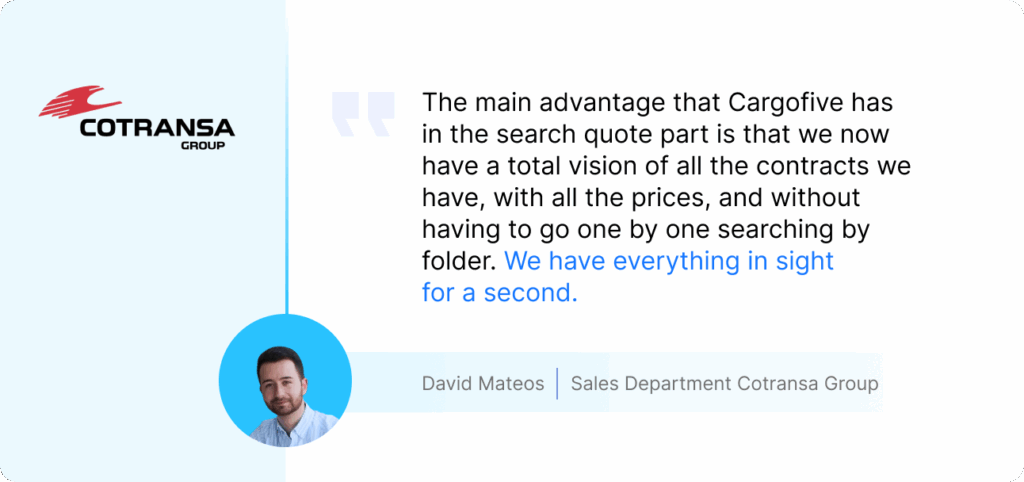
Strategies for Freight Forwarders to Stay Competitive
Given all these challenges, what should freight forwarders actually do to stay competitive in 2025 and beyond?
Invest in Digital Rate Management
This isn’t optional anymore. The forwarders winning business are the ones who can quote accurately and quickly.
Manual rate management puts you at a severe disadvantage. While you’re spending hours searching for rates, your competitors using digital platforms are sending quotes to customers in minutes.
The ROI on automated rate management is immediate and measurable. Faster quotes mean you win more business. Accurate rates protect your margins. Reduced manual work lowers your operational costs.
Build Multi-Carrier Relationships
Relying heavily on one or two carriers creates risk. When they face capacity constraints, equipment shortages, or schedule problems, your entire operation suffers.
Building relationships with multiple carriers gives you:
- Alternative routing options when your primary carrier faces issues
- Negotiating leverage for better rates and terms
- Access to different vessel schedules and service options
- Reduced risk from carrier-specific disruptions
The challenge with multi-carrier relationships used to be managing all those different rate sheets and contracts. Digital platforms solve this by centralizing all carrier rates, making it easy to work with many carriers without administrative burden.
Focus on Emerging Trade Lanes
While everyone is focused on traditional Asia-US routes, significant growth is happening in other corridors:
Asia to Latin America: Manufacturing nearshoring is driving unprecedented growth in these routes.
Intra-Asia trades: Regional manufacturing networks are creating new shipping patterns within Asia.
South-South trades: Direct routes between developing economies are growing faster than traditional North-South lanes.
Getting established in these emerging lanes early gives you first-mover advantages before they become overcrowded.
Standardize Your Processes
Process standardization isn’t just about efficiency. It’s about consistency and scalability.
When every customer quote requires a custom approach, you can’t grow without proportionally growing headcount. Standardized processes let you handle more volume with the same team.
This includes:
Quote request templates. Standard formats for gathering customer requirements ensure you get all necessary information upfront.
Pricing calculation templates. Consistent methods for calculating total costs prevent errors and make quotes comparable.
Communication protocols. Clear processes for updating customers about shipments reduce time spent on status calls.
Documentation checklists. Standard lists of required documents prevent booking delays from missing paperwork.
| Process Area | Before Standardization | After Standardization |
| Quote turnaround time | 4-24 hours | 15-30 minutes |
| Pricing accuracy | 85% | 98%+ |
| Missing documentation rate | 25% | Less than 5% |
| Customer status inquiries | 10-15 per shipment | 2-3 per shipment |
Managing Customer Expectations in Volatile Markets
One of the hardest parts of ocean freight in 2025 is managing customer expectations when everything keeps changing.
Be Transparent About Market Conditions
Your customers read the news. They know ocean freight is volatile. What they need from you is honest communication about what’s happening and how it affects them.
When rates spike, explain why. When transit times extend, provide context. When schedule changes happen, communicate proactively.
Transparency builds trust. Customers who understand the challenges you’re navigating are more patient when problems arise.
Set Realistic Timelines
Promising arrival dates you can’t meet destroys credibility. In today’s environment, building appropriate buffers into transit time estimates protects your reputation.
This doesn’t mean making everything slower. It means being realistic about current conditions and giving customers timelines you’re confident you can meet.
Provide Options and Trade-offs
Different customers have different priorities. Some need the absolute lowest cost. Others prioritize speed or reliability above price.
When you can present options with clear trade-offs, customers can make informed decisions:
- “Carrier A is cheapest but has longer transit time”
- “Carrier B costs 10% more but has better schedule reliability”
- “Route C avoids congested ports but adds three days to transit”
This consultative approach positions you as a strategic partner, not just a transaction processor.
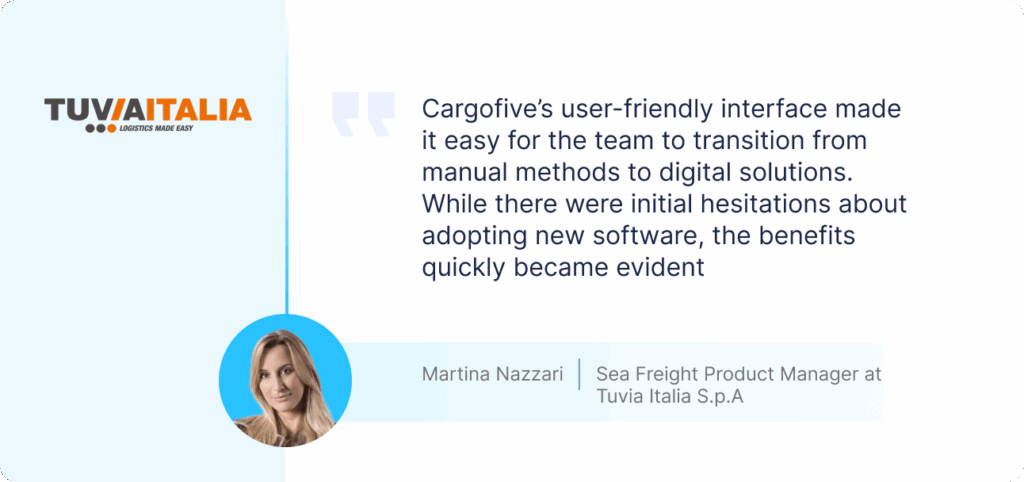
The Sustainability Factor in Ocean Freight
Environmental considerations are increasingly influencing ocean freight decisions. This isn’t just about corporate social responsibility anymore. It’s becoming a business requirement.
Regulatory Pressures
Carbon emissions regulations for shipping are tightening globally. The International Maritime Organization has set ambitious targets for reducing shipping emissions, and regional regulations in Europe and elsewhere are even more stringent.
These regulations create costs that flow through to shippers. Understanding these costs and how they’ll evolve helps you guide customers through the changing landscape.
Customer Demands for Green Shipping
Many shippers now require carbon reporting for their ocean freight. Some are willing to pay premiums for lower-emission shipping options. Others face pressure from their own customers to demonstrate supply chain sustainability.
Freight forwarders who can provide:
- Carbon emissions calculations for shipments
- Options for lower-emission routing or vessel choices
- Documentation for customer sustainability reporting
…have a competitive advantage with sustainability-focused customers.

Looking Ahead: Preparing for Future Shifts
The ocean freight industry will continue evolving rapidly. What should freight forwarders do to prepare?
Build Flexible Operations
Rigid processes and systems that worked in stable markets become liabilities in dynamic environments. Building flexibility into your operations means:
- Technology platforms that can adapt to new carriers and routes easily
- Staff cross-trained to handle different tasks as volumes shift
- Relationships with diverse carriers and service providers
- Financial structures that can handle rate volatility
Invest in Your Team’s Skills
Your team needs different skills for today’s ocean freight environment than they did five years ago. Technology proficiency is becoming as important as logistics knowledge.
Training your team on digital tools, data analysis, and problem-solving in complex situations prepares them to handle whatever changes come next.
Stay Connected to Market Intelligence
Understanding what’s happening in global trade, manufacturing trends, and logistics innovation keeps you ahead of shifts before they fully impact your business.
This doesn’t mean you need to become a market analyst. But staying informed through industry publications, carrier updates, and customer conversations helps you spot trends early.
Real Results from Digital Transformation
Let’s talk about actual results freight forwarders are seeing from digital transformation.
Companies that have automated their rate management report:
80-90% reduction in quote generation time. Quotes that took hours now take minutes.
25-40% increase in quote volume capacity. The same team can handle significantly more customer requests.
Significant improvement in quote accuracy. Fewer margin-eroding errors from outdated rates or miscalculations.
Better win rates on quotes. Faster response times lead to more won business.
These aren’t theoretical benefits. They’re measurable improvements that directly impact profitability.
Taking the First Steps
If you’re still managing ocean freight rates manually, the gap between you and digitally-enabled competitors grows wider every day.
The good news? You don’t have to transform everything overnight.
Start with the biggest pain point in your operation. For most freight forwarders, that’s rate management and quote generation.
Look for platforms that offer:
- Quick implementation without major IT projects
- Integration with carriers you already work with
- Connections to your existing systems
- Training and support to get your team up to speed
The best platforms offer free trials so you can see the benefits firsthand before committing.
Conclusion: Adapting to Win in the New Ocean Freight Reality
The shifts in global trade aren’t slowing down. Ocean freight will remain volatile, complex, and challenging for the foreseeable future.
But these challenges create opportunities for freight forwarders who adapt.
The companies thriving in this environment share common characteristics. They use technology to operate faster and more accurately than competitors. They build diverse carrier relationships that provide flexibility. They standardize processes to scale efficiently. And they communicate transparently with customers about market realities.
The ocean freight market has changed permanently. The question is whether your operation is changing with it.
The freight forwarders who embrace digital transformation, particularly in rate management and customer communication, are capturing more business at better margins. Those clinging to manual processes are falling further behind.
Which side of that divide will your company be on?

Frequently Asked Questions
How do I convince my team to adopt new digital tools for ocean freight management?
Start by identifying the pain points your team experiences daily with manual processes. Most freight forwarders find that quote generation takes too long, rate lookups are frustrating, and tracking down current pricing is time-consuming.
Show your team how digital tools directly solve these specific problems. The best approach is running a pilot program where a few team members use the new system alongside existing processes. When they see how much faster and easier it makes their work, they become advocates who help bring the rest of the team along.
Remember, good digital platforms are designed to be intuitive and reduce work, not add complexity.
With ocean freight rates changing so frequently, how can I protect my profit margins when quoting customers?
Rate volatility is one of the biggest margin killers for freight forwarders. The solution involves three strategies working together. First, use automated rate management that gives you access to current rates the moment you quote, eliminating the risk of using outdated pricing.
Second, be transparent with customers about rate validity periods, making it clear that quotes are only valid for a specific timeframe, usually 3-7 days in volatile markets. Third, build appropriate margins into your quotes that account for typical surcharge variations.
Digital platforms that connect to live carrier rates help with all of this by showing you exactly what rates are valid right now and automatically calculating all surcharges.
Should I focus on traditional Asia-US ocean freight routes or invest in emerging trade lanes?
You don’t have to choose one or the other exclusively. The smart strategy is diversification. Traditional transpacific routes still move enormous volumes and will remain important, but they’re also mature markets with intense competition.
Emerging lanes, particularly Asia to Latin America and intra-regional routes, offer growth opportunities with less competition. The key is having the operational capability and carrier relationships to serve multiple trade lanes efficiently.
Digital platforms make this easier by giving you rate access across 50,000+ global trade lanes without needing separate systems for each corridor. Start by adding one or two emerging lanes where you see customer demand, then expand as you build expertise.
What’s the realistic ROI timeline for implementing digital rate management for my freight forwarding business?
Most freight forwarders see measurable ROI within the first 30-60 days of implementing digital rate management. The returns come from multiple sources. Time savings are immediate because quote generation drops from hours to minutes.
You’ll likely see increased quote volumes because your team can handle more requests with the same headcount. Win rates typically improve because faster quotes capture more business. And margin protection from accurate, current rates prevents the costly errors that happen with manual processes.
Calculate your ROI by looking at how many hours your team currently spends on rate lookups and quote generation each week, then multiply by your labor costs. That’s your baseline savings, before factoring in increased business from faster service.
How do I choose between different digital freight management platforms?
Focus on three critical factors. First, carrier connectivity is what determines if the platform actually solves your rate management problems. Look for platforms with direct integrations to 20+ major ocean carriers and access to rates across global trade lanes you serve.
Second, implementation speed matters because you need results quickly, not six months from now. The best platforms can have you up and running in days, not months. Third, consider integration capabilities with your existing TMS or ERP systems. You don’t want another disconnected tool that creates more manual work.
Look for platforms offering free trials so you can test functionality with your actual rates and workflows before committing. Talk to other freight forwarders using the platform to get honest feedback about real-world performance.
AUTHOR

